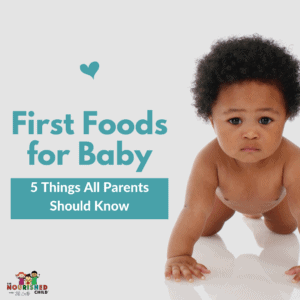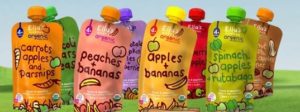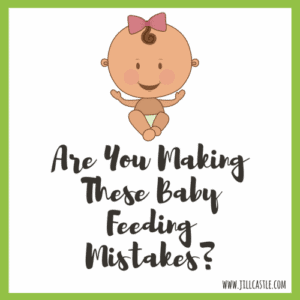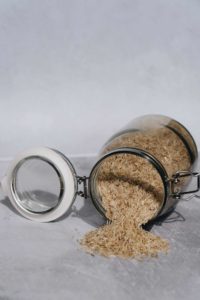The Ultimate Guide to Baby’s Nutrition in the First Year
January 27, 2023
Whether you’re a new or experienced parent, you want to know that your baby gets the right amount of food and all the essential nutrients. So let’s dive into your baby’s nutrition during the first 12 months.
The first year is an exciting time. Whether you spoon feed or practice baby-led weaning (BLW), a baby’s nutrition begins with liquids, then proceeds to purees or modified food for BLW. Eventually, your little one will self-feed and eat the food your family eats.
As your baby transitions through the feeding stages, you might have new worries and questions about healthy and safe feeding.
In this article, I dive into some of the most common questions from parents about baby feeding from 0 to 12 months old.
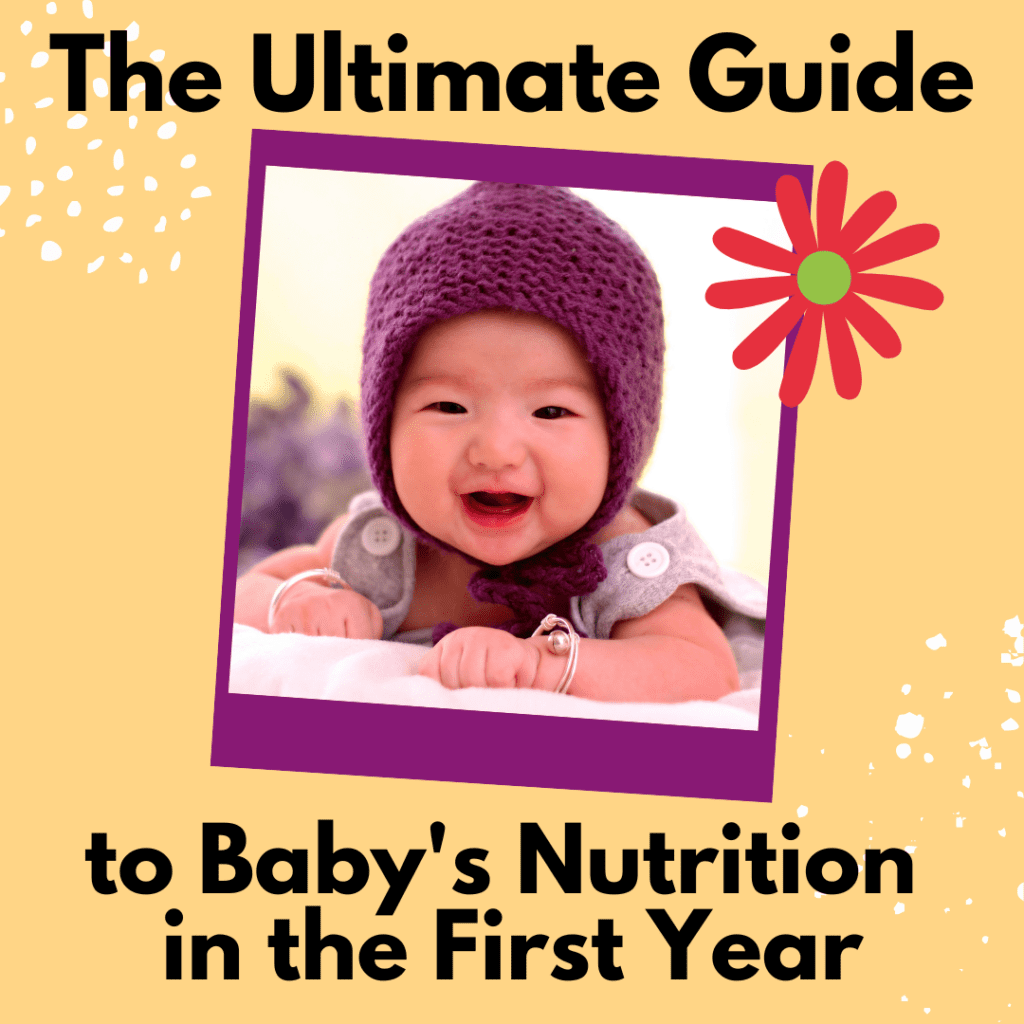
Why Is Your Baby’s Nutrition So Important?
Nutritious food is essential for kids at every stage of childhood. Not only do babies need calories and nutrients to maintain their health, they also need enough to keep up with growth spurts and the development of their brains.
Getting enough nutrients and calories is especially important for babies. Good nutrition keeps them on track to meet their developmental and physical milestones.
Here are a few reasons you don’t want to miss out on good nutrition for babies in the first year of life.
Failure to Thrive (FTT)
When babies don’t get enough or proper nutrition, they are at higher risk for failure to thrive (FTT). Failure to thrive happens when a child doesn’t gain expected or adequate weight for their age, or tracks at less than the fifth percentile on the weight curve in their age group, according to standardized growth charts. FTT can come from poor or inadequate nutrition.
Children with failure to thrive may have long term cognitive deficits and are smaller compared to kids without failure to thrive.
Failure to thrive may happen for several reasons: lack of access to nutritious foods, appetite loss, illness, oral aversion, or extreme picky eating are other reasons a baby may fall behind on their growth chart.
Nutrient Deficiencies
Did you know a baby’s weight triples and his brain doubles in size by the time he’s 12 months old?
That’s a lot of growth spurts in the first year!
This period of rapid physical and cognitive development requires essential vitamins and minerals. Nutrient deficiencies during this critical window can lead to stunted growth, physical impairment, and long-term cognitive deficits.
Strong Immunity
The nutrients found in breast milk, formula and nutrient-dense complementary foods help build a baby’s immune system.
Iron, zinc and vitamin C are key nutrients in defending the body against infections and illness. So when infants don’t get the nutrients they need from their diet they’re more susceptible to getting sick.
Children have a higher risk of getting very sick with diarrhea or other common childhood viruses when their immune system is weak. A healthy immune response can fight off germs and viruses more easily.
(Fruits and vegetables are full of immunity-boosting nutrients like vitamin C, vitamin A and antioxidants!)
What Are the Most Important Nutrients for Babies?
Formula or breast milk have the right balance of macronutrients (carbohydrates, fat, and protein) and vitamins and minerals for this critical time of life.
While all nutrients are important, iron, protein, fat, and vitamin D are crucial for growth and development in a baby’s first year. When it’s time to introduce solid foods, pay special attention to these nutrients.
Iron
Iron is best known for its role in red blood cells, but it’s also a critical nutrient for healthy brain development. Inadequate iron in the diet can lead to iron deficiency, which can lead to iron-deficiency anemia, slowed growth and cognitive and developmental delays.
Baby Iron Needs
Infants 0 – 6 months old need 0.27 mg of iron daily
Infants 6 – 12 months old need 11 mg of iron daily
Iron is a nutrient that the body can store. In fact, newborns have enough iron stored for the first six months of life, as long as their mothers had an iron-rich diet while pregnant, and had good iron status at delivery.
The formula manufactured in the U.S. contains enough iron to meet a baby’s needs. Breastfeeding babies get iron from their mother’s diets and their own iron stores. Complementary feeding starts just in time (at six months old), when a little one’s iron stores become depleted.
Iron-rich foods should be a big part of your little one’s diet. Meat is an excellent source of iron but there are some plant-based foods that are also good sources of iron. Plus, many foods, like ready-to-eat cereal, are fortified with iron.
Vitamin D
Calcium and vitamin D are needed for healthy bone growth. A vitamin D deficiency in babies and young children can cause rickets, which leads to softening and weakening of the bones. When children with rickets start walking, they can develop bowed legs.
Baby Vitamin D Requirements
Infants 0 – 12 months old need 10 μg of vitamin D daily (or 400 IU)
Calcium is easier to get from the diet than vitamin D, which isn’t naturally found in many foods. Vitamin D is a hormone made in the body from the vitamin D found in food or from exposure to the sun.
But, depending on where you live, you may not have enough time in the sun to prevent vitamin D deficiency. For example, if you live in the northeast, you’re exposed to the sun fewer days of the year than those in the southwest.
Parents are encouraged to protect their little ones from the sun’s harmful rays with hats and sunscreen. So little ones may miss out on the benefits of the sun.
While fortified formula has all the vitamin D a baby needs, breastfeeding babies need a vitamin D supplement.
Fat
Fat is a critical nutrient for brain formation and weight gain. Because babies have tiny tummies, fat is a calorie-rich nutrient that ensures they get adequate calories for growth. In fact, breastmilk and infant formula contain about 50% of their calories from fat.
As your baby starts real food, the fat content of the diet is especially important. Continued use of breast milk and infant formula when introducing solid foods ensures babies get enough fat in their diet.
DHA is an omega-3 fat and is found in large quantities in the brain and retina. It’s essential for brain and eye development. Breastmilk contains DHA and is a good source for baby as long as mothers have a DHA-rich diet. Many infant formulas are fortified with DHA.
Protein
Protein plays a vital role in tissue growth and repair, which is essential for all stages of life but especially for babies who are in a rapid stage of growth.
In the first 6 months of life, breastfeeding and formula meet an infant’s protein needs. When it’s time to drop a bottle feed, be sure to include a good protein source using complementary foods.
Eggs, yogurt, cheese, tofu, chicken, and beans are a few baby-friendly protein options.
Baby’s Nutrition: 0 to 6 Months
Babies should only consume liquids from 0 to 6 months old. So let’s dive into the benefits and considerations of the three primary baby feeding methods.
1. Breast Milk
The WHO and the AAP recommend exclusive breastfeeding infants for the first six months. Breast milk contains protein, vitamins, fatty acids, and antibodies that help strengthen a newborn’s immune system.
Colostrum is the first milk produced after the baby is born. It’s a thinner consistency than later breast milk and is rich in antibodies to protect the newborn. The composition of breast milk changes and meet a baby’s nutritional needs as a little one grows.
Aside from nutrients, breastfeeding has many health benefits for baby and mother. According to the CDC, breastfeeding reduces the risk of diabetes, asthma, food allergies, sudden infant death syndrome, and ear infections.
Mother’s benefit too. Breastfeeding lowers the risk of breast and ovarian cancer, type 2 diabetes, and high blood pressure.
2. Infant Formula
Baby formula is a good baby feeding option for families. The “recipe” for infant formula is based on the ingredients and nutrients in breast milk. Although infant formula isn’t an exact replica of breast milk, it affords mothers and caretakers who can’t breastfeed or who need more flexibility a nourishing option.
Infant formula is formulated to meet the iron and vitamin D requirements of babies.
Infant formula allows parents and caretakers to share in the joy and responsibility of feeding their little one. It gives the primary parent a break from overnight feedings. Some mothers may also find formula more convenient than pumping breast milk when they return to work.
Can you add rice cereal to bottles?
Rice cereal in the bottle is not recommended. While some parents may add rice cereal to the bedtime bottle to keep a baby from waking up for a night feeding, . doing so is a choking hazard. It can also cause constipation and lead to excessive weight gain.
But you can add a dollop of pureed veggies to train your little one’s taste buds to like vegetables! There’s even evidence that early flavor training prevents picky eating later.
3. Combination of Breast Milk and Formula
In this method, parents use both breast milk and infant formula to nourish their baby. Babies get the health benefits of breast milk while parents get the flexibility of supplementing feedings with a bottle.
Some mothers are concerned about producing enough milk to fill their baby’s belly. Or, they don’t yield enough milk from pumping to feed the baby when they’re not home. Being able to add a formula bottle when needed helps.
La Leche League suggests parents introduce a bottle once breastfeeding has been established after four weeks.
Baby Feeding at 6 to 12 Months
Once your baby turns 6 months, it’s time to introduce solid food!
Most healthy babies are ready for soft or pureed foods around 6 months old. The signs your baby is ready for solid food include sitting upright independently and showing interest in the food you’re eating.
Formula or breast milk should continue as a source of nutrition until your baby is one-year-old.
At around 6 months old, complementary foods help fill your little one’s belly and offer a source of critical nutrients like iron.
The transition to solids is important for development as well. Babies practice their chewing skills, learn table manners, and try a variety of foods, flavors and textures.
Allergies and choking hazards are two common concerns parents have about introducing solid foods.
Recent studies found that introducing food allergens to babies early may prevent children from developing a food allergy. Whatever baby feeding method you choose for your little one, follow the food introduction guidelines.
Introduce one new food at a time. Then, wait 1 to 3 days to observe any reactions before introducing another food. Read more on how to introduce allergens to your baby.
Spoon Feeding Your Baby
Stage 1 puree foods are traditionally the first foods offered to babies. The benefit of spoon feeding is that parents know how much their baby eats and there’s a lower risk of choking with purees. Babies usually go from infant cereals, to pureed fruits and vegetables, then on to pureed meats.
Store-bought baby food is convenient, although there are concerns about toxins found in baby food. If you prefer to skip the stage 1 store-bought foods, you can make homemade baby food or try baby-led weaning (BLW).
Baby-Led Weaning with Baby
Instead of spoon feeding purees to your little one, BLW encourages babies to self-feed soft, mashed or food cut up into finger-length, graspable pieces. This feeding method relies on responsive feeding–learning to notice your baby’s signs of hunger and offering modified foods that the family typically eats.
Babies develop a taste preference for the foods they’ll be eating as they get older. It’s also an opportunity to practice feeding skills. One benefit is BLW teaches children to regulate their hunger by learning to listen to their hunger and fullness signals.
The best foods for baby-led weaning are foods that are easy for babies to pick up and hold, chew with their gums and safely swallow. Bananas, sliced avocados, strips of cooked sweet potatoes, and cheese strips are some first BLW foods.

Spoon feeding + BLW
Some parents prefer to use a combination method of feeding, using both the spoon and the baby-led weaning approach.
Start by offering soft or modified foods from the table when your little one shares mealtime with the family. Use the spoon, too, by letting your baby practice those fine motor skills with a preloaded spoon of puree so they can self-feed.
Feeding Schedule for Baby’s Nutrition
In my experience as a child nutritionist, parents have two main questions about their baby’s nutrition and feeding: how much and how often should babies eat?
How often do newborns eat?
The answer depends on whether your baby is formula or breastfed, born prematurely or full term, and of course, your baby’s appetite. There’s no set schedule for all babies, only recommendations (I have some below).
How much should a baby eat?
How much a baby should eat is different for everyone. Babies are hungrier during periods of rapid growth and less hungry when growth slows. Healthy babies are good at regulating food intake, so I encourage you to be responsive with feeding and watch for signs of hunger and fullness.
Here are some general feeding schedules for healthy, full-term babies. The schedule may be different for you depending on what time your baby wakes up in the morning and naps during the day.
6-month feeding schedule
At 6 months, babies drink approximately 6-8 oz formula every 4 to 5 hours and eat 2 to 3 small meals.
- 7 am bottle
- 9 am nap
- 11 am bottle
- 12 pm small meal + nap
- 3 pm bottle
- 6 pm dinner
- 6:45 pm bottle
- 7 pm bedtime
9-month-old feeding schedule
At 9 months, infants usually drop a nap and a bottle feed.
- 7 am bottle
- 8 am breakfast
- 9 am nap
- 11 am bottle
- 12 pm lunch
- Nap
- 4 pm bottle
- 6 pm dinner
- 7pm bottle
- Bedtime
1-year-old feeding schedule
At 1-year-old, it’s time to transition babies from formula and bottles and provide whole milk in a cup. At this age, kiddos eat 3 meals and 2 to 3 snacks daily.
Here’s an example of a 1-year-old feeding schedule.
- 8 am breakfast and milk
- 10 am snack
- 12 pm lunch
- 3 pm snack
- 6 pm dinner and milk
An easy way to keep up with your baby’s progress in the first year is with my Free Baby Food Tracker & Journal.

FAQ’S About Your Baby’s Nutrition
When can babies have water?
Babies rarely need extra water until they eat solid foods at around 6 months. Formula and breast milk have enough fluid to keep babies hydrated. Extra liquids can fill a baby’s tiny tummy and displace a bottle feeding. If that happens, babies may not get enough calories and nutrients.
At around 6 months old, you can offer 2 to 3 ounces of distilled or boiled and cooled water with meals. If your area doesn’t have fluoridated water, ask your pediatrician if they recommend bottled water that contains fluoride.
Can a newborn eat too much?
Newborns can eat too much, especially if fed from a bottle.
There are a variety of nipple types and sizes to choose from and it’s important you have the right nipple for your infant. Babies drink quickly to keep up when the flow is too fast and may eat too much.
Look for signs of fullness, such as sucking on their fingers, turning away from the bottle or breast or spitting up. When you notice these signs, stop feeding and wait until your little one shows signs of hunger again.
Is rice cereal bad for babies?
When it’s time to introduce solids, rice cereal is a popular first food. It’s easy to digest, so it’s less likely to upset a baby’s tummy. And, rice cereal has a very low risk of allergic reactions. But it’s been reported that rice cereal contains arsenic.
Arsenic is found in soil and many foods that grow in soil have trace amounts in them. However, rice has a relatively high amount of arsenic compared to other foods. For this reason, I recommend offering a variety of single grain cereals to minimize the risk of rice cereal.
According to the AAP, rice cereal doesn’t have to be a baby’s first food. Instead, AAP suggests offering other infant grain cereals, including oatmeal, barley, or multigrain cereals or using meat as a first food to ensure adequate iron consumption.
Can you overfeed a baby?
Yes, it’s possible to overfeed a baby once they begin to eat solid foods at around 6 months.
Kids may be natural intuitive eaters (unless they unlearn how to follow their hunger and fullness signs). But, too many ultra-processed foods and added sugars can quickly add up to more calories than a baby needs for growth. And snacking throughout the day, even on healthy snacks, is another common source of overfeeding.
It’s important to remember that baby and toddler appetites fluctuate depending on growth spurts, size and activity level. It’s not necessarily overfeeding if your baby is hungrier than usual and in a growth spurt. But if you find yourself pushing for that “clean plate,” or finishing the bottle, you may be overfeeding your baby. Read more about what to expect with the feeding dynamic in the first year.
Some signs of overfeeding are vomiting, gas, a sudden increase in their growth chart or not showing signs of hunger at the next meal or snack.
Can babies eat corn?
Babies younger than 18 months old can choke on whole corn kernels. Corn on the cob is the safest way to serve younger babies. First, remove all the husks and silk and boil or steam the corn cob until it’s soft.
Cut the cob into sections that are easy for your little one to hold. It’s also good for strengthening chewing skills.
What do I do if my baby doesn’t want to eat?
It’s perfectly normal for a baby’s appetite to fluctuate. Babies go through several growth spurts in the first year and hunger increases to support rapid growth.
But, if your infant turns away from the bottle, gags while eating or shows signs of pain and discomfort, he might be refusing food for physical reasons. First, rule out any medical causes for appetite loss, such as illness, teething, pain from food intolerance, or mouth or tongue issues.
For bottle-fed babies, try changing the flow with a different nipple, or moving your baby into a different position.
Never force-feed a baby but do try to keep them hydrated. Babies can dehydrate quickly, so let your pediatrician know if your baby refuses to eat.
Are your baby’s nutrition milestones on track? Get my free guide to feeding goals and milestones for the first year.




